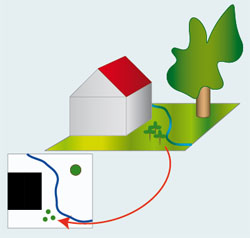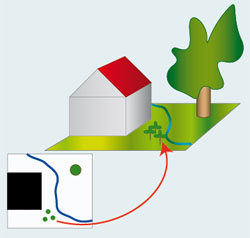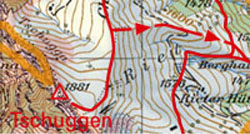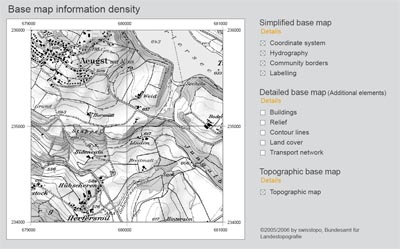Base map
The base map establishes the geometrical and orientational reference for the viewer of a thematic map. This way, familiar features such as lakes and rivers, place names, localities and mountains, administrative boundaries, terrain shape, transportation routes, forests and land cover help the map viewer for orientation.
When designing a base map, the following aspects should be considered.
The basemap
- should be tailored to the thematic content, however, a complete matching with the topic should be avoided
- should complement the included topic in the most reasonable way, while distracting as little as possible
- must correspond to the current state
- must match the scale and the degree of generalisation of the thematic content to be included
- should not exceed twice the scale and a miniaturization should be avoided completely
Functions
According to Spiess (1995), the base map serves five purposes. These are explained in the following sections. Elaborated information on the intended use of base maps can be found here (German version only).
| Mapping thematic content A topographic base map serves as the basis when mapping elements in their geospatial context. Depending on the topic and method of acquisition, the topographic map can either be rich in detail (e.g. in the case of a topographic map or an aerial image) or a reduced map is sufficient, which comprises only the most rudimentary elements for orientation. |
 |
| Relocating map contents to the field A basemap is also necessary when relocating thematic contents of a map to the field. It allows to relocate the exact position of objects in the field. A prerequisite for such a faultless relocalisation is that the complete thematic information of a map is available and can be read easily. All inventory maps are examples for such maps. |
 |
| Comparing thematic contents of different maps of the same region Maps with different thematic and temporal contents, which relate to the same area, can be easily compared if topographic base elements are present. This is also true for complex contents. By comparing different maps, new thematic relationships and perspectives can be generated. |
| Localising thematic contents in the existing geographic field of perception It is one of the most important tasks of a map to place a subject in a geospatial context for the map viewer, for example using objects that can be easily recognized, such as coast sections, lakes, river networks, landforms, transportation networks. The selection of these elements depends on topic and the target audience of the map. |
| Comparing the thematic content with the components of the base map The comparison of thematic information with the topographic background allows for a deeper interpretation of the topic in relation to the geographic environment. For this purpose, the emphasis lies on the relationship between topic and topography. This means that for the base map a tight correlation of the topographic elements and the topic should exist. |
 reproduced with permission from swisstopo (BA057224) reproduced with permission from swisstopo (BA057224) |
Information density
The information density of the base map depends on the topic to be depicted. It is distinguished between a base map that is rich in detail and one that is simplified. In addition, orthophotos and topographic maps can be used as base maps. The following interaction shows the different kinds of base maps.
Graphical requirements
When designing a base map, it is important to make sure that the thematic map is not being dominated by the topographic information. The base map should stay in the background. To achieve this, Spiess (1995) proposes several means to reduce contrast. These are introduced in the following interaction.
In addition to the mentioned measures, the basemap should be generalised
according to the topic. It should be paid attention that the characteristic
structure is preserved.

